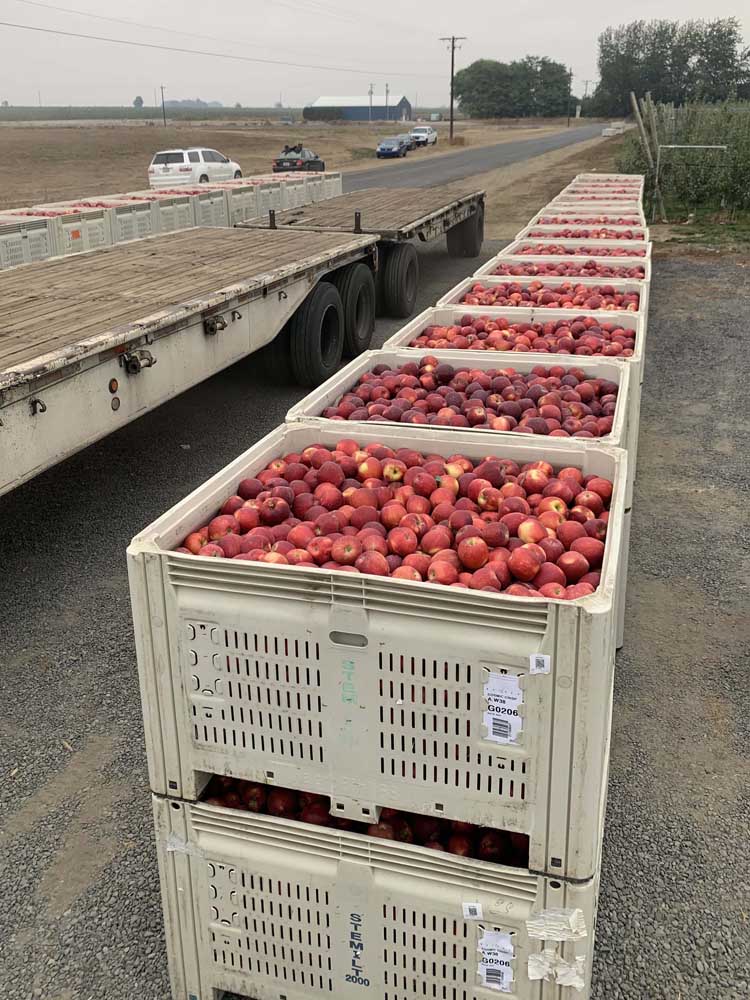Cosmic Crisp apple expands into new markets, still faces challenges
Published 4:15 pm Tuesday, November 22, 2022

- Cosmic Crisp apples in bins, fall 2022.
This year’s crop of Cosmic Crisp apples — the largest yet — began rolling into stores Dec. 1.
Growers continue to face challenges, including less-than-ideal prices, but their hopes for the Cosmic Crisp are buoyed by new marketing opportunities and growing demand.
“I think this year for Cosmic Crisp could be fantastic,” said Todd Fryhover, president of Washington Apple Commission.
Although the total 2022 apple crop is smaller than average due to storms, the Cosmic Crisp performed well through cold weather.
“It was one of the few varieties that set quite nicely and picked out at or above growers’ estimates,” said Kathryn Grandy, chief marketing officer for Proprietary Variety Management, a Yakima company contracted to commercialize WA 38, Washington State University’s cultivar trademarked as Cosmic Crisp.
PVM estimates 5% to 7% of Cosmics were un-harvestable due to frost damage.
“Our crop set was actually decent. It was better than I thought it would be,” said Andy Handley, who grows Cosmic Crisps in Quincy, Wash.
Volumes are rapidly increasing.
“We’re ramping up on production,” said Jon DeVaney, president of Washington State Tree Fruit Association, or WSTFA.
In 2019 — the variety’s inaugural year on the market — the crop filled 360,000 standard 40-pound boxes. That rose to 1.6 million boxes in 2020 and about 3.8 million boxes in 2021. WSTFA estimates this year’s crop will reach 5.5 million boxes.
Last November, 17 million Cosmic Crisp trees had been planted across Washington; this November, nurseries have sold 19.6 million trees, representing about $750 million of investment.
Some growers are concerned the variety “may be overplanted,” which could lead to oversupply.
Fryhover, of the commission, conceded that this could happen as it has with other varieties — “volume goes up, prices go down” — but he said he isn’t worried about a flooded market in the next 3 to 4 years. The industry continues to fall short of production estimates, he said, and has room for more volume.
Grandy, of PVM, is optimistic about demand. The variety, she said, has achieved 27% national brand awareness.
Domestically, Cosmic Crisps are selling best on the West Coast. Other top marketplaces include Chicago, New York City, Washington, D.C., and Texas. The next push will be into Midwest and Southeast markets.
Fryhover estimated 20% of the crop will be exported this season. The top export market is Canada, followed by Taiwan, Mexico and Vietnam. Grandy said the brand is also planning a “robust launch” across Europe in 2023.
Prices the past few years have zigzagged.
During the apple’s 2019-2020 rookie season, freight-on-board, or FOB, prices started at $63.92 per box. Cosmic Crisp’s 2020-2021 sophomore year, coinciding with the COVID-19 pandemic, was bumpy: FOB prices plunged from a high of $71.86 per box to $43.83, a 38% drop.
Prices improved somewhat last marketing season. According to PVM, the industry finished the 2021-2022 crop year with average FOB prices of $48.57.
Prices for the 2022-2023 season are not yet known, as the crop’s release date was Dec. 1.
The Cosmic Crisp, the result of 22 years of breeding and development by WSU, has long storage and late ripening behavior. It must be kept in cold storage for weeks after harvest so the fruit can develop optimum levels of sugars and starches before release.
Different packer-shippers take different marketing approaches. Some are opportunistic, looking for the best deals. Others aim for continuity and permanent shelf space. Stemilt Growers, a major producer, recently announced it will provide Cosmic Crisp apples year-round.
Grandy, of PVM, said quality is “fantastic” on Cosmics that have been in storage for 13 months.
Industry data show smaller apples, sizes 80-100, command the highest prices.
In the apple industry, the larger the number, the smaller the fruit size. For example, a size 100 apple is smaller than a size 64.
The challenge is that the variety tends to skew large, considering one of its parents is the Honeycrisp. Last year, about 65% of apples produced were larger, in the 48-72 range.
Industry experts say sizing moderates as trees mature. Growers can also take action to aim for smaller-sized fruits, such as doing less thinning.
However, orchardists say controlling fruit size is challenging because the trees tend to naturally thin themselves.
The benefit of a self-thinning variety is that it means less work for laborers.
Yet while the variety is low-maintenance in some ways, it demands high labor inputs in others. For example, Cosmic Crisps have stiff stems that pickers must clip so they won’t punch holes in other apples. Clipping slows down harvest, doubling the time it takes to fill a bin.
Although growers still have a lot to learn about the new variety, Fryhover of the commission said he thinks this year presents “a tremendous opportunity” for producers to expand their markets.
More Orchard, Nuts & Vines






